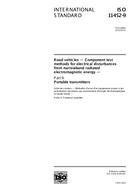We need your consent to use the individual data so that you can see information about your interests, among other things. Click "OK" to give your consent.

ISO 11452-9:2012
Road vehicles — Component test methods for electrical disturbances from narrowband radiated electromagnetic energy — Part 9: Portable transmitters
Automatically translated name:
Road vehicles -- Component test methods for electrical disturbances from narrowband radiated electromagnetic energy -- Part 9: Portable transmitters
STANDARD published on 16.5.2012
| Availability | Sold out |
| Price | ONREQUEST excl. VAT |
| ON REQUEST |
The information about the standard:
Designation standards: ISO 11452-9:2012
Publication date standards: 16.5.2012
SKU: NS-423181
The number of pages: 47
Approximate weight : 141 g (0.31 lbs)
Country: International technical standard
The category - similar standards:
Annotation of standard text ISO 11452-9:2012 :
Description / Abstract: ISO 11452-9:2012 specifies test methods and procedures for testing electromagnetic immunity to portable transmitters of electronic components for passenger cars and commercial vehicles, regardless of the propulsion system (e.g. spark-ignition engine, diesel engine, electric motor). The device under test (DUT), together with the wiring harness (prototype or standard test harness), is subjected to an electromagnetic disturbance generated by portable transmitters inside an absorber-lined shielded enclosure, with peripheral devices either inside or outside the enclosure. The electromagnetic disturbances considered are limited to continuous narrowband electromagnetic fields.
We recommend:
Updating of laws
Do you want to be sure about the validity of used regulations?
We offer you a solution so that you could use valid and updated legislative regulations.
Would you like to get more information? Look at this page.



 Cookies
Cookies
